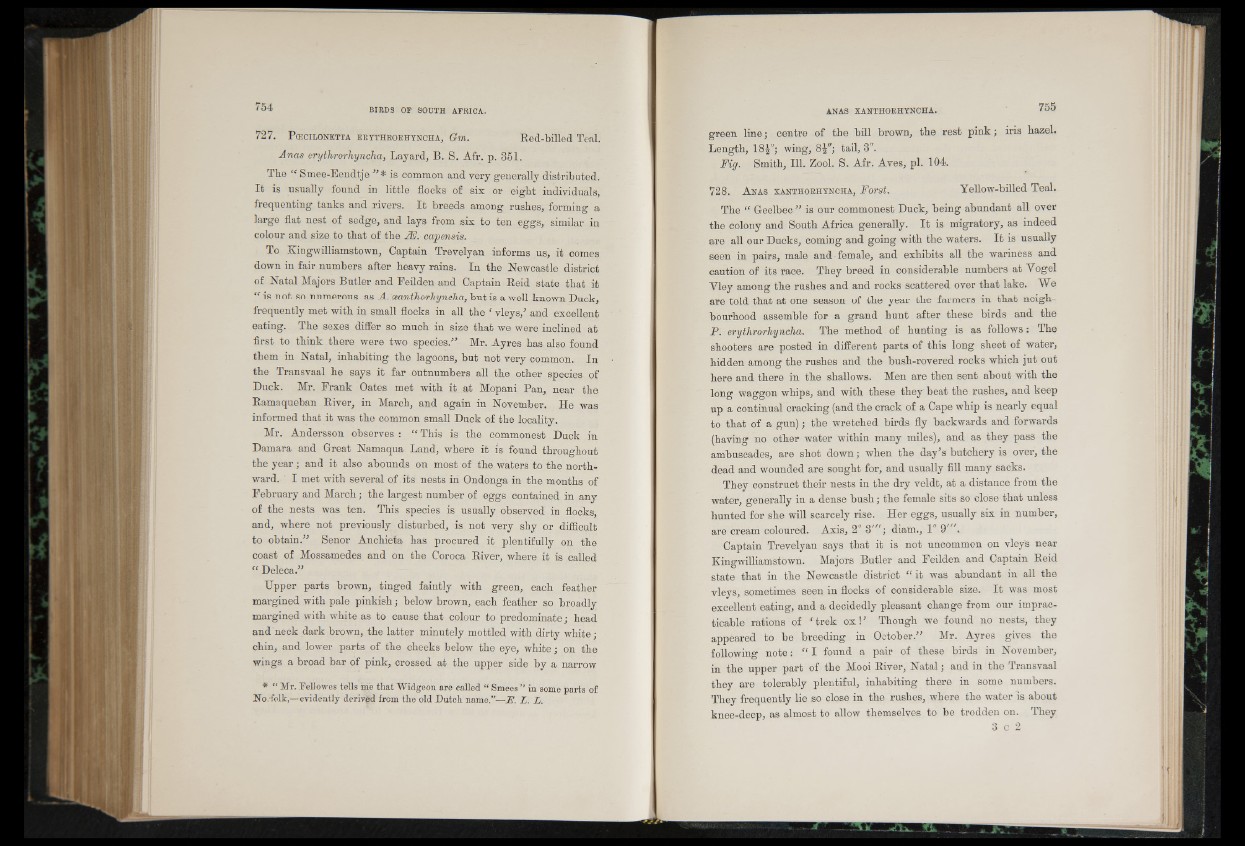
727. P cecilonetta erythrorhyncha, Gm. Red-billed Teal.
Anas erythrorhyncha, Layard, B. S. Afr. p. 351.
The “ Smee-Eendtje ”* is common and very generally distributed.
It is usually found in little flocks of six or eight individuals,
frequenting tanks and rivers. I t breeds among rushes, forming a
large flat nest of sedge, and lays from six to ten eggs, similar in
colour and size to that of the 2E. capmsis.
To Xingwilliamstown, Captain Trevelyan informs us, it comes
down in fair numbers after heavy rains. In the Newcastle district
of Natal Majors Butler and Feilden and Captain Reid state that it
“ is not so numerous as A. xanthorhyncha, but is a well-known Duck,
frequently met with in small flocks in all the ‘ vleys/ and excellent
eating. The sexes differ so much in size that we were inclined at
first to think there were two species.” Mr. Ayres has also found
them in Natal, inhabiting the lagoons, but not very common. In
the Transvaal he says it far outnumbers all the other species of
Duck. Mr. Frank Oates met with it at Mopani Pan, near the
Ramaqueban River, in March, and again in November. He was
informed that it was the common small Duck of the locality.
Mr. Andersson observes : “ This is the commonest Duck in
Damara and Great Namaqua Land, where it is found throughout
the year • and it also abounds on most of the waters to the northward.
‘ I met with several of its nests in Ondonga in the months of
February and March; the largest number of eggs contained in any
of the nests was ten. This species is usually observed in flocks
and, where not previously disturbed, is not very shy or difficult
to obtain.” Senor Anchieta has procured it plentifully on the
coast of Mossamedes and on the Coroca River, where it is called
“ Deleca.”
Upper parts brown, tinged faintly with green, each feather
margined with pale pinkish; below brown, each feather so broadly
margined with white as to cause that colour to predominate; head
and neck dark brown, the latter minutely mottled with dirty white;
chin, and lower parts of the cheeks below the eye, white; on the
wings a broad bar of pink, crossed at the upper side by a narrow
* * Mr. Fellovres tells me th a t Widgeon are called “ Smees ” in some parts of
No .'folk,—evidently derived from th e old Dutch name.”—E . L . L .
green line; centre of the bill brown, the rest pink; iris hazel.
Length, 184"; wing, 84"; tail, 3".
Fig. Smith, 111. Zool. S. Afr. Aves, pi. 104.
728. A n a s x a n t h o k h y n c h a , Forst. Yellow-billed Teal.
The “ Geelbec ” is our commonest Duck, being abundant all over
the colony and South Africa generally. I t is migratory, as indeed
are all our Ducks, coming and going with the waters. It is usually
seen in pairs, male and female, and exhibits all the wariness and
caution of its race. They breed in considerable numbers at Yogel
Yley among the rushes and and rocks scattered over that lake. We
are told that at one season of the year the farmers in that neighbourhood
assemble for a grand hunt after these birds and the
P. erythrorhyncha. The method of hunting is as follows: The
shooters are posted in different parts of this long sheet of water,
hidden among the rushes and the bush-rovered rocks which jut out
here and there in the shallows. Men are then sent about with the
long waggon whips, and with these they beat the rushes, and keep
up a continual cracking (and the crack of a Cape whip is nearly equal
to that of a gun); the wretched birds fly backwards and forwards
(having no other water within many miles), and as they pass the
ambuscades, are shot down; when the day’s butchery is over, the
dead and wounded are sought for, and usually fill many sacks.
They construct their nests in the dry veldt, at a distance from the
water, generally in a dense bush; the female sits so close that unless
hunted for she will scarcely rise. Her eggs, usually six in number,
are cream coloured. Axis, 2" 3'"; diam., 1" 9"'.
Captain Trevelyan says that it is not uncommon on vleys near
Kingwilliamstown. Majors Butler and Feilden and Captain Reid
state that in the Newcastle district “ it was abundant in all the
vleys, sometimes seen in flocks of considerable size. It was most
excellent eating, and a decidedly pleasant change from our impracticable
rations of ftrek ox!’ Though we found no nests, they
appeared to be breeding in October.” Mr. Ayres gives the
following note: “ I found a pair of these birds in November,
in the upper part of the Mooi River, Natal; and in the Transvaal
they are tolerably plentiful, inhabiting there in some numbers.
They frequently lie so close in the rushes, where the water is about
knee-deep, as almost to allow themselves to be trodden on. They